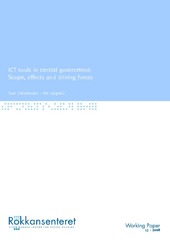| dc.contributor.author | Christensen, Tom | eng |
| dc.contributor.author | Lægreid, Per | eng |
| dc.date.accessioned | 2010-11-01T12:49:51Z | |
| dc.date.accessioned | 2020-12-10T06:34:10Z | |
| dc.date.available | 2010-11-01T12:49:51Z | |
| dc.date.available | 2020-12-10T06:34:10Z | |
| dc.date.issued | 2008-11 | eng |
| dc.identifier.issn | 1503-0946 | |
| dc.identifier.uri | https://hdl.handle.net/1956/4300 | |
| dc.description | This paper is written as a part of the project «The Norwegian central government administration in a 30 years perspective», mainly funded by the Meltzer Foundation, University of Bergen. An earlier version of the paper was presented at the annual conference of the European Group of Public Administration (EGPA) at the Erasmus University, Rotterdam, September 3–5 2008, the Study Group on «Organizing Public Sector Organizations». | en |
| dc.description.abstract | Dette notatet beskriver utbredelse og bruk av ulike IKT verktøy i norsk sentraladministrasjon. Det fokuseres på «e-government» og «e-domocracy» og på opplevde effekter av IKT på økonomi, kvalitet, åpenhet, samordning, politisk og administrativ kontroll og brukermedvirkning. Notatet tar også sikte på å forklare betydningen av ulike IKT verktøy på effektoppfattelser i forhold til andre faktorer som strukturelle trekk, demografiske kjennetegn og trekk ved forvaltningskulturen. Hovedfunnene er for det første at interne IKT verktøy er mest utbredt og at «edemocracy» tiltak har fått liten oppmerksomhet. For det andre er de største opplevde effekten knyttet til bedre offentlige tjenester, økt åpenhet og bedre intern samordning og administrativ kontroll. De ansatte rapporterer svakere effekter når det gjelder samordning med kommunale myndigheter og bedre politisk styring. De viktigste faktorene for å forstå variasjoner i effektoppfattelser er knyttet til bruk av ulike IKT verktøy, men også strukturelle trekk som forvaltningsnivå og oppgaver spiller en rolle. Det er også effekter av demografiske trekk som alder og kulturelle trekk knyttet til effektivitetsorientering. | en_US |
| dc.description.abstract | This paper describes the scope and use of different ICT tools in the Norwegian central government by focusing on both e-government and features of e-democracy; and the perceived effects of ICT on economy, service quality, transparency, coordination, political and administrative control and user participation. It also aims at explaining the influence of ICT tools on variations in such perceived effects relative to other factors influencing decision-making behaviour in the central civil service, such as structural features, demography and administrative culture. The major findings are, first, that government-to-government tools are the most widespread and that e-democracy tools have received little attention. Second, the effects are strongest regarding better public services, increased transparency and internal coordination and administrative control and weakest when it comes to coordination with local government and political control. Third, the most important set of explanatory variables are the use of ICT tools, but also structural features such as administrative level and tasks makes a difference as well as demographic features (age) and cultural features such as having an efficiency oriented culture. | en_US |
| dc.language.iso | eng | eng |
| dc.publisher | Stein Rokkan Centre for Social Studies | eng |
| dc.relation.ispartofseries | Working Paper | en |
| dc.relation.ispartofseries | 13-2008 | en |
| dc.title | ICT tools in central government | eng |
| dc.type | Working paper | eng |
| dc.rights.holder | Copyright Stein Rokkan Centre for Social Studies. All rights reserved | |
| dc.subject.nsi | VDP::Samfunnsvitenskap: 200 | nob |
